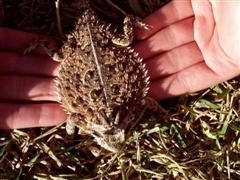Horned Toad
Horny Toad, Horned Toad Lizard, Horned Lizard Scientific Name: Phrynosoma platyrhinos
Thu, 3rd July, 2025 - 8:13 am GMT
Sponsor Ads:

Alternative Name
Horny Toad, Horned Toad Lizard, Horned Lizard Scientific Name: Phrynosoma platyrhinosBasic Info
Horned Toads are usually brown to gray in coloring, and measure between three and seven inches in length. Some are more creamy or white in color, and others may have colorful markings. It all depends on the Horned Toad's habitat, since it relies on its color for camouflage. They are spiny to discourage predators. The horns, which give these lizards their name, are actually modified scales over the back and sides of their heads. Horned Toads have large stomachs in order to hold lots of insects without hampering the animal's ability to move about. Children commonly catch Horned Toads, because their flat shape makes it rather difficult for them to move quickly or agilely. They generally have an overall round shape.
Health
Be careful when handling Horned Toads because they cannot regenerate their tails like the majority of lizards can. Their tails do not easily detach. Breeding Generally, Horned Toads will produce eggs or live young, depending on the species. The young grow extremely quickly.Habitat
Southern Canada down to GuatemalaBehavior
The amazing little Horned Toad is actually quite common in many areas of the Americas and is gentle enough to be handled by the children who often enjoy catching these animals. When a Horned Toad feels threatened, it may hiss and puff out its body to look larger. If the danger does not disperse, the Horned Toad will squirt blood out of glands located in the corners of its eyes in order to scare the attacker away. Its spine also protects it from the snakes, roadrunners and coyotes that try to eat it. To catch these insects, the Horned Toad will remain motionless until the prey comes close to it. It may take a few steps toward the insect, or if the prey is close enough, flick out its tongue to catch it. A Horned Toad can eat as much as 100 ants in just one day. Most of the water Horned Toads need is obtained from their food or from dew or raindrops on plants. It has been reported that the Horned Toad cannot handle fire ants. The rumor around central Texas is that the fire ant is responsible for the relative scarcity of the Horned Toad in this area. When it rains, Horned Toads use their backs to funnel water into their mouths. At night, the Horned Lizard burrows into the ground to bury itself a few inches beneath the surface and emerges in the day to bask. When they are too hot, Horned Toads will seek shade in a bush or may bury themselves. They can also hibernate in winter, and because of these adaptations, Horned Toads can inhabit climates from temperate woodlands to deserts.Origin
North and South AmericaHistory
Horned Lizards, or Horned Toads as they are more commonly called, make their homes all the way from southern Canada down to Guatemala, effectively encompassing almost all of North and Central America. Called Horny Toads by many children, these gentle but frightening looking little lizards are a common sight in many warm or dry areas.Common Foods
Horned Toads usually feed on insects and eat ants, beetles, grasshoppers and spiders to name a few prey items.Sponsor Ads:
Beware the fury of a patient man.
Horned Toad
Coded by: BGID® | ALL RIGHTS RESERVED Copyright © 2000-2025
Disclaimer | Privacy | Report Errors / Contact | Credits








 Preparing For China. China is growing their military. China Military Technology - can it keep up with the US?
Preparing For China. China is growing their military. China Military Technology - can it keep up with the US?  versus
versus 

 versus
versus 
 This Thread is about the North Korean Military itself - the kind of army, navy, and air force they have.
This Thread is about the North Korean Military itself - the kind of army, navy, and air force they have. 
 versus
versus 
 versus
versus  versus
versus